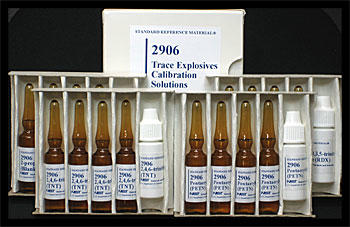
SRM 2906 includes four ampoules of each of the three explosives and a blank along with a dropper bottle for each. NIST researchers formulated the concentrations of these solutions to be near but above the detection limit of commercial swipe-type detectors, which are commonly based on ion mobility spectrometry.
Trace-explosives detectors (TEDs) are an increasingly common sight at airports and on loading docks, and emergency response personnel carry them to evaluate suspicious packages. A new test material developed by the National Institute of Standards and Technology (NIST) in cooperation with ASTM International enables users of these products to evaluate their performance and reliability.
The new testing material, NIST Standard Reference Material (SRM) 2906, Trace Explosives Calibration Solutions, was designed to meet the specifications of ASTM E 2520-07, Standard Practice for Verifying Minimum Acceptable Performance of Trace Explosive Detectors. ASTM is one of the leading industrial organizations for the development of voluntary consensus standards.
The NIST reference material contains calibration solutions of three high explosives: RDX (an ingredient in Composition C-4), PETN, and TNT. Under the test protocol, users sequentially apply a single drop of explosive solution and a solvent blank to swipes, the solvents are allowed to evaporate, and the instrument is tested. A simple 'yes-no' alarm checklist is used to determine TED performance.
SRM 2906 includes four ampoules of each of the three explosives and a blank along with a dropper bottle for each. NIST researchers formulated the concentrations of these solutions to be near, but above, the detection limit of commercial swipe-type detectors, which are commonly based on ion mobility spectrometry. When tested with the solutions, properly functioning TEDs should provide an alarm response.
This SRM fully satisfies the need for independent test materials with low uncertainties in concentrations necessary for reliable TED evaluation. Equipment vendors may use the SRM to improve and optimize their designs and demonstrate to their customers how well their machines function. Buyers may use the SRM to make sound procurement decisions. The combination of a validated standard practice and SRM will provide TED users with a reliable means of verifying initial and continuing field performance of their equipment, contributing to the fight against explosives terrorism.
Development of SRM 2906 was sponsored by the Science and Technology Directorate of the U.S. Department of Homeland Security. For more information on SRM 2906, see https://www-s.nist.gov/srmors/view_detail.cfm?srm=2906. For more information on ASTM E 2520-07, see www.astm.org/Standards/E2520.htm.
SRMs are among the most widely distributed and used NIST products. The agency prepares, analyzes and distributes more than 1,000 different carefully characterized materials that are used throughout the world to check the accuracy of instruments and test procedures used in manufacturing, clinical chemistry, environmental monitoring, electronics, criminal forensics and dozens of other fields. For more information, see NIST's SRM website www.nist.gov/srm/.

